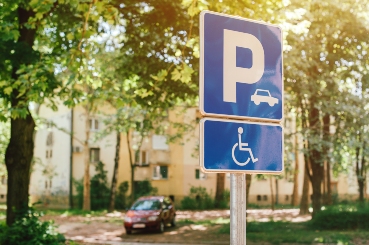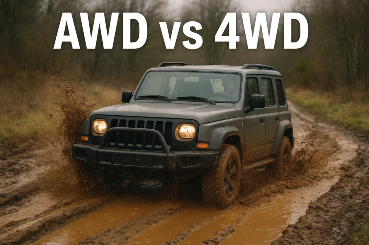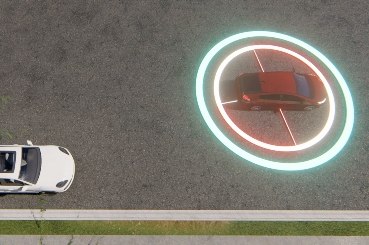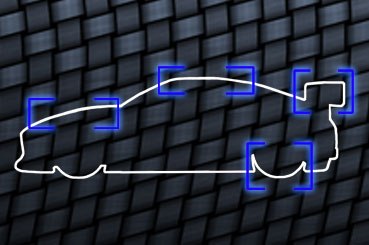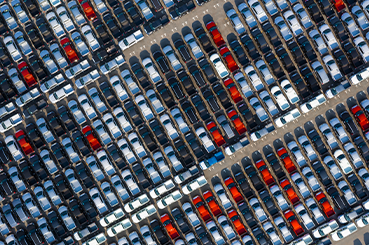
The majority of new cars now come equipped with an array of advanced drive-assist systems. These systems have been developed to help make motoring safer and easier.
There is an array of drive-assist systems now on the market, from features which help to make parking easier to systems that will brake for you in the event of a collision. They have become so mainstream that many of these drive-assist systems are now tested as part of the Euro NCAP test.
In this guide, we take a look at some of the most common drive-assist features including lane-keep assist, adaptive cruise control and emergency braking assist. This should give you a better understanding of the drive-assist features currently on offer.
Different car manufacturers have developed their own drive-assist safety systems. This means that the systems may differ slightly, so the descriptions given are a rough guide of what you may expect. In addition, many manufacturers have named their systems differently, so where appropriate we have included some common alternative names for the system.
What Are Drive-Assist Features and Why Do Cars Have Them Now?
Drive-assist features have become an integral part of modern vehicles, offering a range of advanced technologies to enhance driving safety and convenience. These features utilise sensors, cameras, and sophisticated computer systems to assist drivers in various tasks, such as maintaining a safe following distance, preventing lane departures, and even automatically braking to avoid collisions.
One of the primary motivations behind the widespread adoption of drive-assist features is a concerted effort to reduce the number of accidents on the road. By providing real-time alerts and taking proactive measures to prevent accidents, these technologies can significantly improve road safety. Additionally, drive-assist features can contribute to enhanced fuel efficiency by optimising driving patterns and reducing unnecessary braking.
Beyond their safety and efficiency benefits, drive-assist features also enhance the overall driving experience. By automating routine tasks, these technologies can reduce driver fatigue and stress, allowing drivers to focus on the road ahead. As these features continue to evolve and become more sophisticated, they are expected to play a pivotal role in shaping the future of transportation, potentially leading to a safer, more efficient, and more enjoyable driving experience.
Types of Drive-Assist Features:
Drive-assist features offer a wide range of technologies designed to enhance driving safety and convenience. To better understand the capabilities of these systems, it is essential to explore the various types of drive-assist features available on today’s vehicles.
This section will delve into the key categories of drive-assist technologies, providing insights into their specific functions and benefits.
Advanced Driver Assistance Systems (ADAS)
Common Names
ADAS, or Advanced Driver Assistance Systems, are also commonly referred to as:
- Driver Assistance Systems
- Driver Assistance Technologies
- Active Safety Systems
- Semi-Autonomous Driving Systems (when used in conjunction with other technologies)
What Does It Do?
ADAS systems are designed to enhance driving safety and convenience by using advanced technologies to assist drivers in various tasks. These systems can:
- Monitor the driving environment for potential hazards, such as other vehicles, pedestrians, or obstacles.
- Alert the driver to potential dangers through visual, auditory, or tactile cues.
- Intervene to prevent accidents by taking direct control of the vehicle, such as applying the brakes or steering.
- Improve driving efficiency by optimising fuel consumption and reducing driver fatigue.
How Does It Work?
ADAS systems typically rely on a combination of sensors, cameras, and computer systems to function. These components work together to:
- Gather data about the driving environment using sensors such as radar, lidar, and cameras.
- Process information using sophisticated algorithms to identify potential hazards and determine the appropriate course of action.
- Take action to assist the driver, ranging from simple alerts to more complex interventions like automatic braking or lane-keeping assistance.
How Does It Operate?
The specific operation of ADAS systems can vary depending on the features included, but generally involves the following steps:
- Sensor data collection: Sensors gather information about the surrounding environment, including the location of other vehicles, pedestrians, and obstacles.
- Data processing: The collected data is analysed by computer systems to identify potential hazards and determine the appropriate course of action.
- Alert or intervention: Based on the analysis, the ADAS system may provide alerts to the driver or take direct action, such as applying the brakes or steering the vehicle.
Be Aware
While ADAS systems can significantly improve driving safety, it’s important to be aware of the following:
- Limitations: ADAS systems are not infallible and may not be able to detect all potential hazards, especially in challenging conditions such as low visibility or adverse weather.
- Driver responsibility: Drivers should always remain attentive and prepared to take control of their vehicle, as ADAS systems are designed to assist, not replace, human drivers.
- Technology updates: ADAS systems may require regular updates to ensure optimal performance and to incorporate new features or improvements.
- Ethical considerations: The development and deployment of ADAS systems raise ethical questions related to safety, privacy, and liability.
- Legal implications: The use of ADAS systems may have legal implications, particularly in the event of accidents.

Hill-Start Assist
Common Names
- Hill Hold Control
- Hill Descent Control
- Auto Hold
What it Does?
Hill-start assist is a safety feature designed to prevent your vehicle from rolling backwards on a steep incline when starting from a stop. It holds the brakes for a short period after you release the brake pedal, giving you time to accelerate without rolling back. This feature is particularly useful in situations where the incline is steep, the road surface is slippery, or the driver is inexperienced.
How it Works?
Hill-start assist utilises sensors to detect when your vehicle is on an incline. These sensors can be located in various parts of the vehicle, such as the wheels, steering wheel, or brake pedal. When the system determines that the vehicle is on an incline, it activates a hydraulic or electronic braking system to hold the brakes.
How it Operates?
- Detection: The system uses sensors to determine if the vehicle is on an incline.
- Braking: When you release the brake pedal, the system automatically applies the brakes to hold the vehicle in place.
- Acceleration: Once you press the accelerator, the system releases the brakes, allowing you to accelerate smoothly.
Be Aware
- Steepness: While hill-start assist is effective on most inclines, it may not be able to prevent rolling back on extremely steep slopes.
- Activation: The system may only activate under certain conditions, such as when the vehicle is stopped for a certain amount of time or when the incline is above a specific threshold.
- Maintenance: Regular maintenance is essential to ensure the proper functioning of hill-start assist. This includes checking the brake system, sensors, and other components involved in the system’s operation.
- Driver Assistance: While hill-start assist is a valuable safety feature, it should not be relied upon entirely. Drivers should still be aware of their surroundings and exercise caution when driving on inclines.
Driver Attention Detection
Common Names
- Driver Drowsiness Detection
- Driver Fatigue Monitoring
- Driver State Monitoring
What It Does?
Driver attention detection systems are designed to monitor a driver’s alertness and detect signs of fatigue or distraction. These systems can help prevent accidents by alerting the driver when they are becoming drowsy or inattentive.
How it Works?
These systems typically use a combination of sensors and algorithms to monitor the driver’s behavior. Common methods include:
- Facial recognition: Cameras track the driver’s facial movements, looking for signs of drowsiness, such as drooping eyelids or yawning.
- Steering wheel input: Sensors in the steering wheel measure the driver’s grip force and steering input. Inconsistent or reduced input can indicate fatigue.
- Eye tracking: Cameras or infrared sensors monitor the driver’s eye movements. Closed or partially closed eyes, or lack of eye movement, are signs of drowsiness.
How it Operates?
When the system detects signs of fatigue or distraction, it typically alerts the driver with a visual or audible warning. This might involve a flashing light, a loud beep, or a spoken message. In some cases, the system may also activate other safety features, such as automatic emergency braking or lane departure warning.
Be Aware
While driver attention detection systems are a valuable safety tool, it is important to remember that they are not foolproof. These systems are designed to provide alerts, but they cannot prevent accidents entirely. It is essential for drivers to take regular breaks, get enough sleep, and avoid driving when they are tired or distracted.
Emergency Call Systems
Common Names
- E-Call
- Emergency call system
- SOS call
What it Does?
E-Call systems are designed to automatically dial emergency services in the event of a serious car accident. They can also be activated manually by the driver or a passenger. This provides a crucial link between the accident scene and emergency responders, potentially saving lives and reducing the severity of injuries.
How it Works?
These systems utilise a built-in SIM card and GPS technology to accurately determine the vehicle’s location. In the event of an accident, the system will automatically send a message to emergency services containing essential information such as the vehicle’s precise location, the number of occupants, and the severity of the accident. This data enables emergency responders to quickly assess the situation and deploy appropriate resources.
How it Operates?
- Automatic activation: E-Call systems are designed to automatically activate in the event of a serious accident. This is typically achieved by detecting the deployment of airbags or seatbelt pretensioners.
- Manual activation: In addition to automatic activation, drivers or passengers can also manually activate the system by pressing a dedicated button. This allows for immediate assistance in situations where automatic activation may not occur, such as minor accidents or breakdowns.
- Emergency call center: Once activated, the system will connect to an emergency call center, where trained operators will assess the situation and dispatch appropriate emergency services. These operators can also provide vital information to the driver or passengers while they await assistance.
Be Aware
- Coverage: E-Call systems rely on cellular networks, so coverage may be limited in certain areas, particularly in remote or rural regions. It’s important to be aware of potential coverage limitations and plan accordingly.
- Language: The language of the emergency call may vary depending on the location of the vehicle and the language settings of the system. While many E-Call systems are equipped with multilingual capabilities, it’s essential to understand the language options available in your region.
- Privacy: While E-Call systems are primarily designed to save lives, it’s important to be aware of privacy concerns and how your personal information may be used. Ensure that you are familiar with the privacy policies of your vehicle manufacturer to understand how your data is collected, stored, and shared.
Active Park Assist
Common names
- Park Assist
- Automatic Parking Assist
- Remote Smart Parking Assist
- Intelligent Parking Assist
- Parking Assistant
- AutoPark
What it does?
You can wave goodbye to embarrassing parking gaffes and nerve-wracking attempts to pull into a parking space. Active Park Assist systems automatically park your car with little or no input from you.
Most park assist systems are designed to operate for parallel parking, as this is considered one of the trickiest manoeuvres by drivers. While more advanced systems can park in virtually any space as well as being able to pull out of the parking space.
In most cases, the car takes control of the steering wheel and will give you instructions on acceleration, braking and the gear you need to be in. However, some manufacturers have developed systems which will complete the entire manoeuvre without any input from the driver at all.
How it works?
To carry out these challenging manoeuvres, laser and sensors are integrated into cars body panels and bumpers. The lasers can measure the gaps between parked vehicles and the sensors detect obstacles.
Lasers and sensors are fitted to both sides of the vehicles to ensure you can park on either side of the road.
How to operate it?
In most cars, you simply press the Park Assist button, and the sensors will assess the area around you for a suitable parking space. The system then alerts you when it has found one. All you have to do is stop and follow the instructions which are usually shown on the touchscreen infotainment system.
Be Aware
These systems are extremely precise and in many cases, the gap only needs to be 1.2 times the length of the car. While this is great for you, remember that not everyone has this system, and they may find it tricky to get out of their space if the gap is too narrow.
Adaptive Cruise Control
Common names:
- adaptive cruise control
- active cruise control
- smart cruise control
- intelligent cruise control
- smart cruise control
- radar cruise control
What it does?
Adaptive cruise control is a more advanced cruise control system. It not only maintains your set speed but can also maintain a set distance between you and the car in front. The distance between you and the car in front can be set manually by you.
Adaptive cruise control with stop and go is an even more advanced system which is capable of functioning at low speeds and will even bring you to a full stop and can start you again.
How it works?
The system uses laser or radar systems mounted within the front of the car. These scan the road ahead of you to measure how far ahead cars are in front of you. This allows the car to slow down if you get too close to a car in front.
How to operate it?
In most cases, you simply accelerate to your desired speed and push the set button on your adaptive cruise control system. You can then use the ‘+’ or ‘-’ buttons accordingly.
Once the speed is set, you can set the gap you wish to maintain from the car ahead (usually set in either metres or car lengths).
Once both speed and distance are set, if the car in front slows down, your car will slow down to maintain the set gap or will alert you to apply the brakes. However, should the car in front shoot off ahead, your car won’t automatically speed up. Instead, it will maintain the set speed you originally set.
Be Aware
The systems vary between manufacturers, so it’s a good idea to get used to the system and its foibles before relying on it. You should also ensure you always stay in complete control of your car.

Adaptive Headlights
Common names:
- dynamic bending lights
- active bending lights
What they do?
Adaptive headlights help to light your path as the headlights follow the direction of steering wheels. This ensures the headlights illuminate the road ahead rather than the side of it.
How they work?
Some dynamic bending headlights incorporate lights that swivel the headlights to where the wheels are pointing. These utilise electronic sensors to detect the speed of the car, how far the driver has turned the steering wheel and the yaw of the car.
Some systems use sensors which direct small electric motors built into the headlight casing to turn the headlights. These typically move up to 15-degrees from the centre position giving them a 30-degree range of movement.
Whereas on other systems, separate lights aimed in a slightly different direction to straight on, are switched on when directed by the sensors.
Most systems include a self-levelling system so that the lights aren’t affected by uneven road surfaces and won’t dazzle oncoming drivers.

Blind-spot Monitoring
Common names:
- side assist
- blind-spot detection
- lane change alert
- side blind-zone alert
- blind-spot information system
- BLIS
- blind-spot collision warning
- blind-spot warning
- blind-spot assist
- lane-change assist
How it works?
The system uses radar waves in order to detect if a car is moving into your blind-spot.
If another car enters your cars blind spot, it will alert you. The warning usually comes courtesy of a light on or near the wing mirror the vehicle has been detected near. Whereas other systems will give an audible cue of the prospective danger.
Some manufacturers will heighten the response if you try to move into an area when unsafe, for example, the steering wheel may vibrate. While others have systems which actually show you what is happening in your blind-spot. While the Honda-e has taken things a step further by replacing wing mirrors with camera systems.
How to operate it?
Blind-spot detection is usually an inbuilt system which starts working as soon as you start driving. Some manufacturers will offer a way to switch off the system.

Automatic Emergency Braking
Common names:
- collision mitigation braking
- city collision mitigation
- forward automatic braking
- active braking
- active brake assist
- autonomous emergency braking
- city safety
- AEB
What it does?
Automatic emergency braking is designed to help prevent accidents occurring by automatically applying the brakes for you if a collision is imminent and you have taken no action. Most systems work for forward-collisions only, although some do incorporate rear systems as well (see rear-cross traffic alert for rear collision avoidance).
Not only does the system help to prevent incidents occurring in the first place, it lessens the impact should an accident occur.
Some automatic braking systems are now so advanced they can not only detect other vehicles but also pedestrians and cyclists, which help to make roads safer for everyone. On top of this, some will also prepare the vehicle for impact by taking action such as tightening restraints.
How it works?
Autonomous emergency braking uses radar, camera and/or lidar-based technology to identify potential collisions ahead of the car. This information is then combined with what the car knows of its own travel, speed and trajectory to determine whether a critical situation is developing.
In most systems, the car will warn the driver first by either a visual or audio cue, however, if no action is taken by the driver the car will then apply the brakes for you.
How to operate it?
AEB acts independently in a critical situation and will apply the brakes automatically if you don’t take action when a collision is imminent.

Rear Cross-Traffic Alert
Common names
- rear cross-path detection
- cross-traffic assist rear
- cross-traffic alert rear
- rear cross-traffic collision warning
- rear traffic monitor
- rear traffic alert
- cross-traffic alert
What it does?
Cross-traffic alert is a driver assistance system which is designed to help make reversing out of a perpendicular parking space easier and safer.
How it works?
Many rear-cross traffic alert systems work in a similar way to blind-spot monitoring systems. They use radar or a combination of camera and radar technology to detect the presence of moving objects in the vicinity of the car’s rear bumpers.
If the car detects movement across the path of the back of the car, it will issue a visual and/or audio cue to the driver.
More advanced systems can detect smaller objects which are harder to see like pedestrians, cyclists and animals.
While some systems are linked to the automatic emergency braking systems, so can even take over and brake for you in the event of a rear-impact collision.
Be Aware
Rear-cross monitoring systems should never replace common sense. You should always check behind you before you start reversing as well as using your mirror thought the procedure
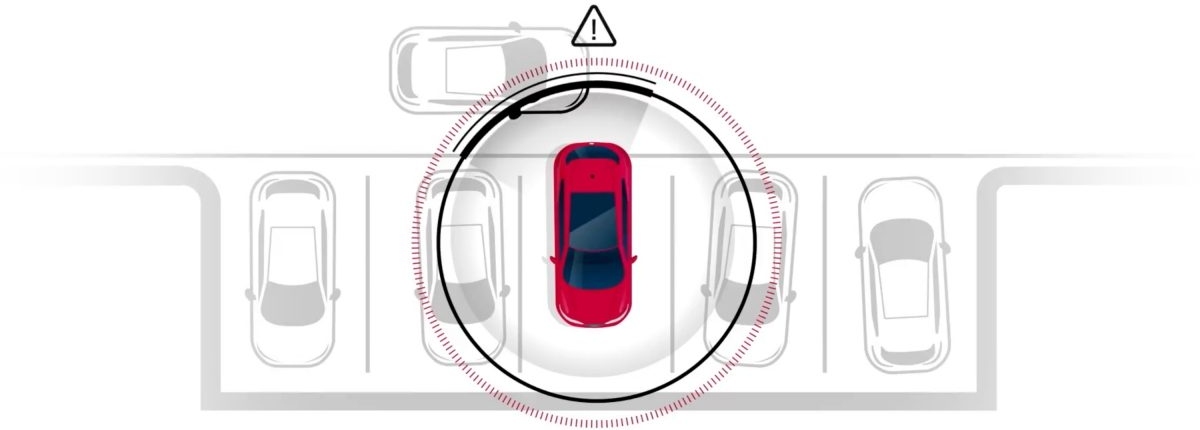
Lane Centring
Common names
- lane-keeping assist
- lane assist
- steering assist
- lane-following assist
- active steering assist
- active lane-keep assist
What it does?
Lane-centring is perhaps the system which most moves towards semiautonomous driving. It monitors the car’s position on the road and can detect if the driver is unintentionally leaving their lane.
It can be a real help for people who spend a lot of time covering motorway miles who are more likely to become distracted or tired.
If movement is detected most cars will react by giving the driver visual or audible alerts. Other systems will provide a more obvious cue like vibrating the steering wheel and some will steer the car back into its lane.
How it works?
The system can usually be switched on or off on the car’s dash. When on, the radar uses a range of sensors, this is commonly a wide-angle camera placed in front of the rear-view mirror. The system then scans the road and identifies the lane lines and monitors the car’s position within the road, usually at speeds over 40mph.
Be Aware
While this system is the next step towards semi-autonomous driving, it is always imperative you stay alert and in control behind the wheel. You should never rely on this system to ‘drive’ for you.
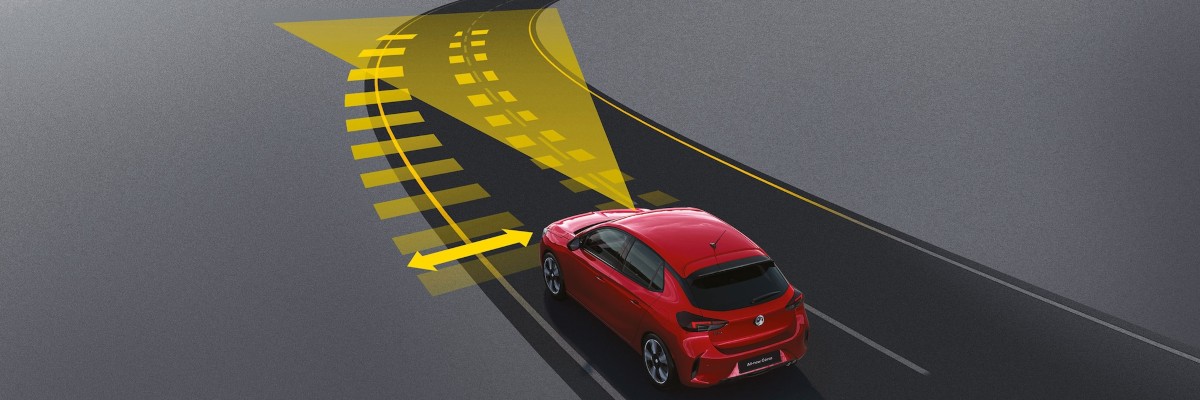
The Growing Prevalence of Drive Assist Features
Drive assist features, once considered luxury amenities, are rapidly becoming commonplace in modern vehicles. Beyond the mandatory safety systems like ABS and airbags, car manufacturers are equipping their models with an expanding array of advanced technologies designed to enhance driving safety, comfort, and convenience.
These features, often powered by cameras, sensors, and sophisticated computer systems, can assist drivers in various tasks, such as:
- Adaptive cruise control: Automatically maintains a safe following distance from the vehicle ahead, adjusting speed as needed.
- Lane departure warning: Alerts the driver if the vehicle is drifting out of its lane.
- Blind spot monitoring: Detects vehicles in blind spots and provides visual or auditory warnings.
- Automatic emergency braking: Applies the brakes automatically to avoid a collision if the driver fails to react in time.
- Parking assist systems: Assists with parallel or perpendicular parking, often including features like automatic steering and braking.
- Traffic sign recognition: Recognises traffic signs and displays relevant information to the driver.
- Driver drowsiness monitoring: Detects signs of fatigue and alerts the driver to take a break.
- Night vision: Improves visibility in low-light conditions.
As these features become more prevalent, it’s likely that we will see even more advanced technologies emerge in the future. Some potential future drive assist systems that may become mandatory include:
- Automated emergency steering: Automatically steers the vehicle to avoid a collision.
- Fully autonomous driving: Enables vehicles to drive themselves without human intervention.
- Predictive accident avoidance: Uses advanced sensors and algorithms to anticipate potential accidents and take preventative measures.
While the proliferation of drive assist features offers numerous benefits, it also raises questions about driver acceptance and preparedness. As these systems become more prevalent, drivers will need to adapt to a new level of automation and reliance on technology. Some experienced drivers, who are accustomed to having full control over their vehicles, may find it challenging to adjust to these systems. However, the potential safety benefits of drive assist features are undeniable, and as they continue to evolve, it’s likely that they will become an essential part of modern driving.
